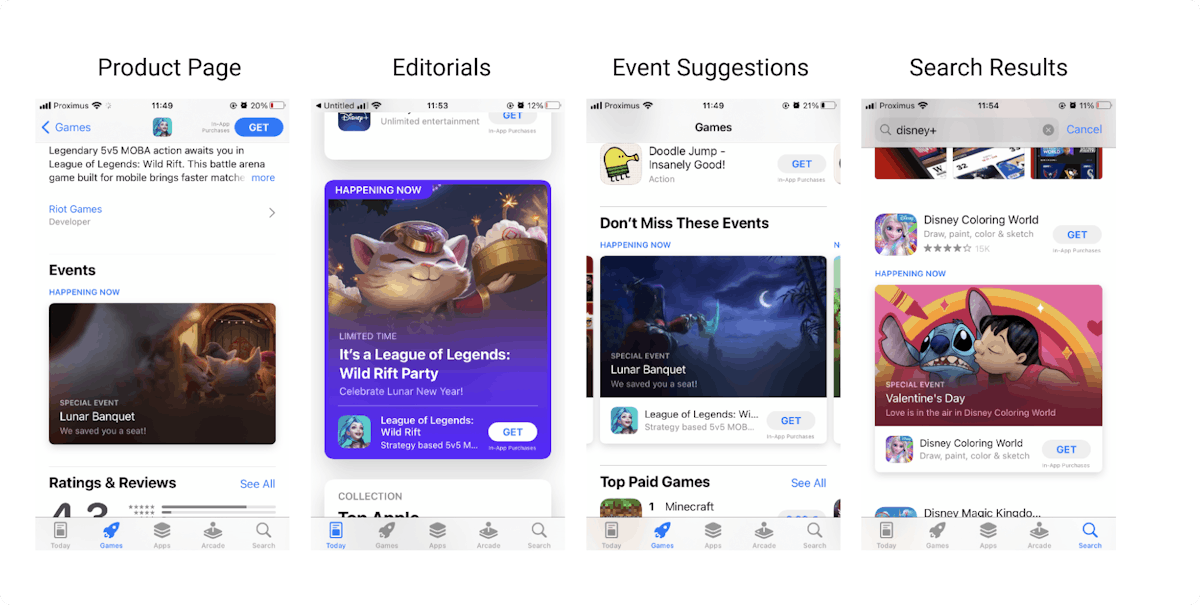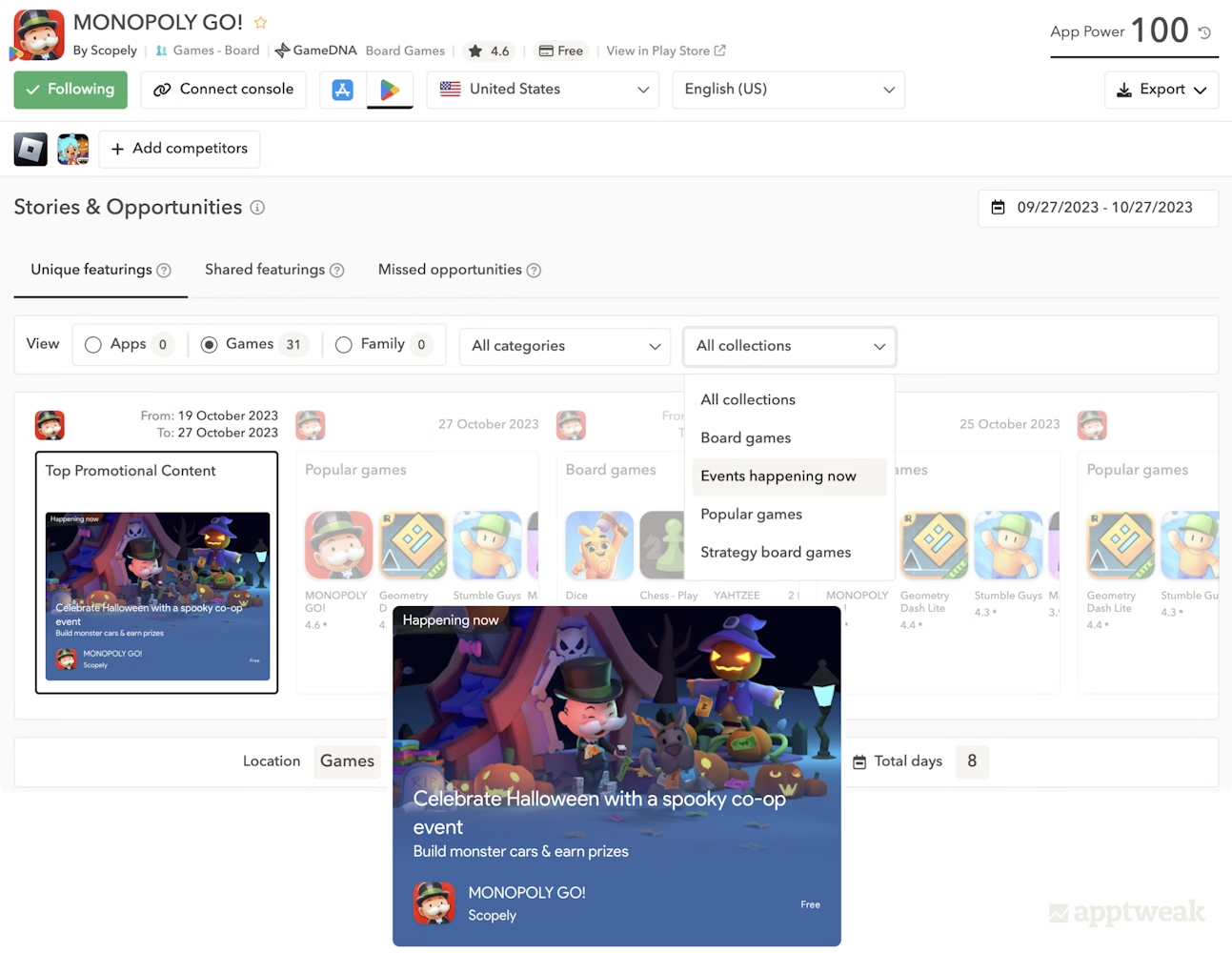
Promotional Content & In-App Events on AppTweak
Back in 2021, Apple introduced a powerful feature with iOS 15 called in-app events. In May 2022, Google announced a series of major updates and new product features for Android developers and publishers. Among these new features, they introduced promotional content (formerly LiveOps), a new functionality – very similar to in-app events – that allows developers to promote in-app activities and content directly on Google Play.
As an ASO pioneer, AppTweak constantly provides its users with the most up-to-date insights, which is why we are the first ASO tool to provide data on in-app events and Google Play promotional content! Read this blog to know everything about new features the ASO community can’t stop talking about.
What are in-app events?
Introduced with iOS 15, in-app events are a great way to promote events within apps and games. This feature allows app developers to showcase special events, such as competitions, challenges, live events, movie premieres, and so on, to reach new users, engage current users, or reconnect with lapsed users.
Discover strategies & best practices for iOS in-app events
When the in-app event has been set up in your console, it will be displayed on your app product page but can also be shown in the App Store editorial sections (Today, Apps, and Games tabs), in the suggested events, and in search results.
 Different ways to find in-app events on the App Store.
Different ways to find in-app events on the App Store.
At any one time, up to 5 events can be published per application and these can span over 31 days. App events can be configured to have different start, end, and publish dates based on the country, and metadata (title, subtitle, description, etc.) in different languages. As a result, you can define a clear strategy depending on the types of users you want to target!
Why are in-app events so impactful for your app?
In-app events will allow you to increase your app visibility and improve user engagement! With this feature, you will be able to:
- Target the right audience for your in-app events: Since you can set up your in-app events according to your target country and language, you don’t have to launch events in regions where they don’t apply (for instance, movie premieres will highly depend on the country you live in).
- Increase your visibility across the store: Apple tries to showcase events happening right now on the store; as a result, your event can be shown by default on the home page and drive even more traffic to your app!
- Increase your search visibility: In-app event metadata is indexed by the App Store algorithm. Therefore, adding in-app events gives you an opportunity to rank on extra keywords. This is another good reason to work on a good in-app event description to get your app in front of potential users.
- Increase your user engagement: It is always nice to run new events so users keep engaging with your app and see it constantly evolving. Some events require special subscriptions, so this may even trigger users to upgrade!
What is promotional content on Google Play?
Google allows you to pick among 5 different types of promotional content (events, major updates, offers, crossovers, or pre-registration announcements) to increase engagement with your users. However, you have to know your target market well enough to strategically decide which type of event you’ll launch and the frequency of these launches.
Unlike in-app events, there is no maximum limit to the number of promotional content an app can run at once on Google Play.

Different ways to find promotional content on Google Play.
Why is promotional content so impactful for your app?
Like in-app events, promotional content has the potential to drive a lot of traffic to an app and increase its conversion rates. The following benefits of in-app events are also applicable to promotional content:
- Target the right audience for your promotional content (based on country/region, or user eligibility).
- Increase your visibility across the store: Promotional content can appear across the Play Store, including on the Apps or Games tab, the Events tab under the Games tab, and on an app’s store listing page.
- Increase your search visibility: Like in-app events, promotional content can also appear in search results on Google Play. However, we do not yet know whether the keywords on promotional content cards can be indexed by the store.
- Increase your user engagement: Arguably, this is the biggest benefit of promotional content on Google Play! In fact, Google stated that apps that had run promotional content during the closed beta registered an average of 5% more active users and 4% higher revenue than apps that had not.
Find expert strategies & examples for promotional content
View in-app events & promo content on AppTweak
When you go to the ASO Report of any app or game in AppTweak, we’ll tell you if we detect an in-app event or promotional content for any app and its competitors.

You can then find more details in the dedicated section of the app’s report. This way, you can quickly check which type of events you and your competitors are currently running, as well as all the event details (dates, requirements, description, etc). If you are looking for new inspiration to design your in-app events, this is the place to be.

For instance, above we see that Pokémon Go is running multiple in-app events at the same time. This strategy can be interesting to diversify your communication and allow more users to engage with one type of event or the other. It can also help you increase your chances of appearing in multiple places across the App Store.
Remember: When launching multiple in-app events, you also have to specify the event priority. Events are put in chronological order; however, by specifying that an event is a priority, it will appear first.
Monitor past in-app events & promo content in the Timeline
What if your competitors aren’t currently running in-app events, but you know they have in the past? Good news! With our ASO Timeline, you can instantly analyze the frequency and duration of your competitors’ in-app events or promotional content (alongside metadata updates, PPO, A/B tests, and more).
AppTweak adds a purple line to indicate any in-app events or promotional content. Clicking the line will display the details of that in-app event in the section below.
Expert Tip
On the App Store, up to 5 in-app events can be published at the same time. On Google Play, there is no maximum limit for promotional content. As a result, our Timeline includes a “dense view” (shown below) that uses a visual heat map system to represent the number of events running at once. The darker the purple shade, the more in-app events or promotional content the app is running.
See featured promotional content in Google Play Explore
Some apps are lucky enough to have their promotional content featured on Google Play, driving extra visibility and Explore traffic directly from the Games or Apps tabs. In AppTweak, you can see which promotional content gets featured, for how long, and where, to identify which of your competitors are being promoted by Google and which assets, events, and promotions they put forward.
In our Explore section, we gather data about all the apps that are featured by the store. You can either have a look at your unique featurings (all the featurings that your app benefited from but not competitors) or your shared featurings (common featurings between you & your competitors). The missed opportunities tab then displays all the featured content your competitors gained, that your app wasn’t part of. You can click on any promotional content card to expand it and see all the details!
For example, below we see that Monopoly Go’s Halloween-themed promotional content was featured in Google’s Games tab:

Different types of in-app events (App Store)
Each in-app event can be created for a specific purpose. Here is a list of all the badges you can pick, along with their definition provided by Apple:
- Challenge: Activities encouraging the user to achieve a goal before the event ends (e.g., a fitness challenge in a workout app or beating a certain number of levels in a game).
- Competition: Activities in which users compete against one another for the highest ranking or to win rewards (e.g., a tournament where players battle to win the most matches).
- Live event: Activities that occur in real-time that all users can experience simultaneously (e.g., a sports match or live-streamed concert). These events should provide users with new content, features, or goods.
- Major update: Introducing significant new features, content, or experiences (e.g., the launch of new game modes or levels). These events go beyond minor enhancements like UI adjustments or bug fixes.
- New season: Introducing new content, storylines, or media libraries to build on established content (e.g., a significant sporting event, a battle pass or themed content in a game, or a special episode of a television show).
- Premiere: Introducing new content or media for the first time (e.g., a movie debut or newly released audio). These events should focus on the introduction of this unique content, rather than promoting general awareness about your app’s content or service.
- Special event: Limited-time events that are not captured by another event badge, possibly spanning multiple activities or experiences (e.g. an event featuring a collaboration). These events should provide users with new content, features, or goods.
Different types of promo content (Google Play)
- Offers: Discounts or $0 items that your users might be interested in, including giveaways for joining an event, discounts, value-adds, and bundles. Offers can be time-limited up to 28 days, or run indefinitely if targeting specific types of users.
- Events: Non-offer time-limited events happening in your app or game, such as tournaments, challenges, player vs. environment events, player vs. player events, or co-operative/alliance events.
- Major update: Significant updates with large new gameplay features or a large new content drop.
- Pre-registration announcements: Updates for pre-registered users informing them of new content, instant app demos, milestone rewards progress, or global release announcements.
- Cross-over: A cross-over between games or IP collaboration event.
Conclusion
We know that Google Play promotional content and in-app events are a big thing for our users. That is why we prioritized these features to show valuable insights before any other tool!
We strongly advise you to take a close look at what your competitors are doing regarding promotional content and in-app events! Monitoring and analyzing strategies in your industry could teach you how (not) to launch events and suggest the creatives you could prioritize.
Thanks to these additions on AppTweak, you will now be able to:
- Understand & get inspired by your competitors’ promotional content and in-app event strategies.
- Get inspired by your competitors’ promotional content and in-app event visuals.
- Understand which types of events are prioritized by your competitors.
- See if competitors are taking advantage of special events to target specific users.
- See how long and how frequently your competitors publish promotional content and in-app events.



 Georgia Shepherd
Georgia Shepherd




 Oriane Ineza
Oriane Ineza